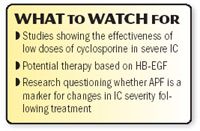Article
Immunosuppressive shows potential in treating severe interstitial cystitis
It's been a long time since urologists have been able to offer interstitial cystitis patients anything new and effective, but that day may be here for patients with the most severe disease.

Key Points

He said urologists who attend IC sessions at the upcoming AUA annual meeting will hear about new studies showing that low-dose cyclosporine (Neoral, Sandimmune), an immunosuppressive drug, has great potential in patients with severe IC. That might mean saving many patients from cystectomies, which can't be counted on to resolve the severe pain these patients have. Certainly, the studies will revive theories about an immunologic basis for at least some IC and will put the spotlight on ongoing research of other immunosuppressives or immune modulators.
The research was spurred by a 2-year-old Finnish study showing that cyclosporine performed better than pentosan polysulfate (Elmiron), with a 75% response rate compared to a 19% response rate in IC patients (J Urol 2005; 174:2235-8). Now, researchers are looking at responses to cyclosporine in more detail in patients with well-defined severe cases of IC and are finding dramatic changes, not only in symptoms, but also in bladder capacity. Investigators are also looking at various urine markers with cyclosporine treatment, including epidermal growth factor (EGF) and nitric oxide (NO), and finding changes along with significant improvement in symptoms.

But should urologists consider using cyclosporine in their practices when they get home from Anaheim?
"It appears that at the doses used in these trials, it was very effective and had minimal side effects, but I'm not advocating that every urologist use it," Dr. Hanno advised. "I think it should be used in the context of more clinical trials because it looks very promising.
"If they have an experienced clinician in their hospital who uses cyclosporine, they might want to consider using it in conjunction with them only for patients who have really severe, refractory IC where the next step is urinary diversion."
Waiting in the wings is potential therapy based on heparin-binding growth factor-like growth factor (HB-EGF), the factor found to allow regrowth of bladder epithelium by counteracting the destructive effects of antiproliferative factor (APF) on bladder lining. Based on research by Susan Keay, MD, PhD and her University of Maryland, Baltimore, and NIH teams, the technology has been licensed by a small biopharmaceutical firm to be researched as a therapy.
Dr. Hanno hopes for that major breakthrough in the next 3 to 5 years.
In the past few years, urologists have heard more about APF as a potential marker of IC, and work is continuing on confirming that, according to Dr. Hanno. At least a unique marker could prove a physical illness to remaining doubters and, more important, health and disability insurers. But they have another important role, he said, which is to show changes with treatment so patients who can benefit from various therapies can be identified.
But research that will also be discussed at the AUA meeting will show that APF may not be a marker that can follow changes in IC severity with certain treatments. Although earlier studies indicated that APF levels changed with neuromodulation therapy, that isn't being borne out with more recent research. More work needs to be done to see whether EGF or NO or nerve growth factor (NGF) might fill that role. Although results with botulinum toxin (Botox) therapy for IC are mixed, some investigators are finding that levels of NGF correlate with reductions in bladder pain.





